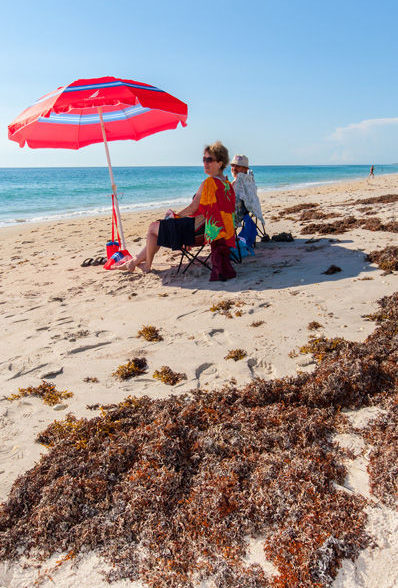
INDIAN RIVER COUNTY — From November to February in the height of season, the City of Vero Beach rakes its beaches of seaweed and other debris twice a week, resulting in the miles of inviting, sandy shore our Northern visitors have come to expect. But all that stops when sea turtles show up.
The earliest species of turtles begins laying eggs in March, then the height of nesting season kicks in two months later in May and runs through Oct. 31.
During that span – which includes the busy summer beach season when kids are out of school – state regulations strictly govern what cities, counties and even private clubs and resorts can do to control debris on their beaches.
City Manager Jim O’Connor said he and the Vero Beach staff and contractors take sea turtle regulations very seriously.
“The last thing we would want is for our people to disturb any of those sea turtle nests,” he said.
To keep trash on the beach under control, Vero pays a contractor to comb public beaches by hand once a week so debris can be removed while leaving seaweed in place.
The seaweed and the tiny critters that get caught up in it provide nourishment for wildlife.
O’Connor said this beach maintenance has not decreased due to budget cuts. But weather conditions, prevailing winds and the presence or absence of tropical storm activity often determine whether and how much seaweed and debris wash up and remain on local beaches.
No storms can mean more seaweed and junk – but the positive side of that is that dunes have likely not been chewed up by storms, either.
Florida Department of Environmental Protection regulations prohibit heavy vehicles (anything that makes more than a two-inch imprint in the sand) from being used for raking or debris removal.
During turtle season, no raking can be done from the water to the mean high water line, or within 10 feet from dune vegetation. On many Indian River County beaches, that doesn’t leave much remaining beach that could be raked under very strict guidelines.
If a government or entity wants to groom the segment of beach in that gap, it must obtain a permit and perform scientific surveys to identify any nesting activity.
Sea turtle nests must be marked with a sign and cordoned off 10 feet around the nest with stakes and survey tape. After all that, debris can be gingerly removed in areas that are not marked as having active turtle nests.
Kendra Cope, Indian River County’s Sea Turtle Coordinator and Environmental Specialist, said that, to her knowledge, the county does not rake beaches at any point of the year, but that some homeowners or homeowner associations do minor grooming and cleaning of beaches, sometimes just moving the seaweed out of the way – but only after surveying is done and nests are marked.
“The unincorporated county areas are more residential and less crowded than beaches at public parks and in front of developed city areas with hotels and businesses. The wrack line that builds due to washed up sargassum weed, other macro algae, and natural debris is extremely important for naturally building the dune system,” Cope said.
“These mats of sargassum are also full of nutrients the dune vegetation needs to thrive. For this reason, I do not foresee me approving beach raking in unincorporated county areas, in hopes that will keep the natural processes of our beaches working,” Cope said.
Cope also said the beach-going public’s help is needed to keep shorelines clean and safe for wildlife. She encouraged visitors to use the trash cans provided at city and county beach parks and beach access points.
“In unincorporated county parks I have not seen any trashcans directly on the beach, but plenty of them in the parking lot and picnic table areas. These are constantly cleaned by park and recreation staff. In the future, I would like to have more recycling bins available to beach guests,” she said. “It is extremely important to me that we, as a community, become more green and work together to recycle our trash so that is does not end up in our oceans and back on our beautiful beaches.”



